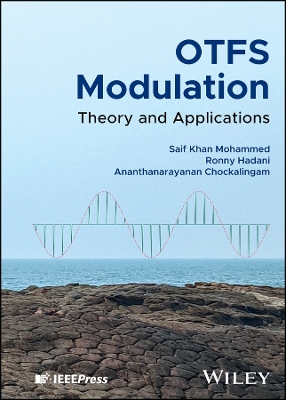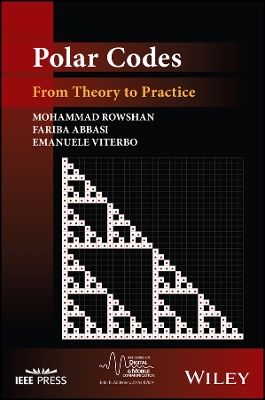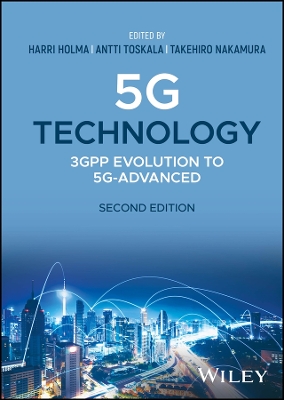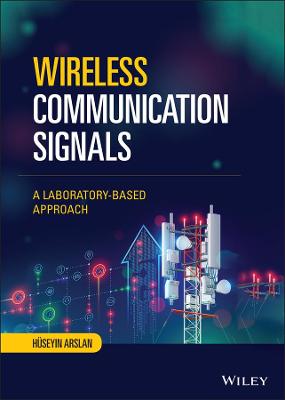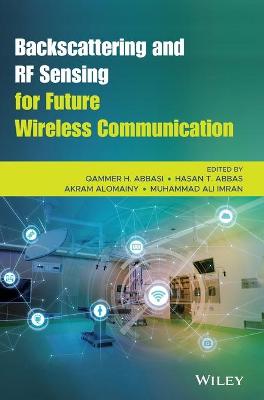Massive Connectivity
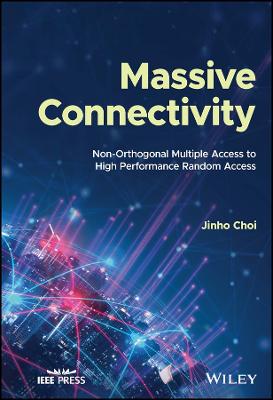 -15%
portes grátis
-15%
portes grátis
Massive Connectivity
Non-Orthogonal Multiple Access to High Performance Random Access
Choi, Jinho
John Wiley & Sons Inc
10/2022
192
Dura
Inglês
9781119772774
15 a 20 dias
392
Descrição não disponível.
Preface xiii
1 Introduction 1
1.1 Machine-Type Communication 1
1.2 Non-Orthogonal Multiple Access 3
1.3 NOMA for MTC 4
1.4 An Overview of Probability and Random Processes 6
1.4.1 Review of Probability 6
1.4.2 Random Variables 7
1.4.3 Random Processes 14
1.4.4 Markov Chains 15
2 Single-User and Multiuser Systems 19
2.1 A Single-User System 19
2.1.1 Signal Representation 20
2.1.2 Transmission of Signal Sequences 21
2.1.3 ML Decoding 23
2.1.4 ML Decoding over Fading Channels 26
2.1.5 Achievable Rate 28
2.2 Multiuser Systems 33
2.2.1 Broadcast Channels 34
2.2.2 Multiple Access Channels 37
2.3 Further Reading 41
3 OMA and NOMA 43
3.1 Orthogonal Multiple Access 43
3.1.1 Time Division Multiple Access 43
3.1.2 Frequency Division Multiple Access 46
3.1.3 Orthogonal Frequency Division Multiple Access 47
3.2 Non-Orthogonal Multiple Access 51
3.2.1 Downlink NOMA 52
3.2.2 Uplink NOMA 57
3.3 Power and Rate Allocation 60
3.3.1 System with Known Instantaneous CSI 60
3.3.2 System with Unknown Instantaneous CSI 67
3.4 Code Division Multiple Access 73
3.4.1 DS-CDMA 74
3.4.2 Multiuser Detection Approaches 78
3.5 Further Reading 84
4 Random Access Systems 87
4.1 ALOHA Systems 88
4.1.1 Single Channel Random Access 88
4.1.2 Multi-Channel S-ALOHA 90
4.2 Throughput Analysis 91
4.2.1 Pure ALOHA 91
4.2.2 Slotted ALOHA 92
4.2.3 Multichannel ALOHA 94
4.3 Analysis with a Finite Number of Users 98
4.3.1 A Markov Chain 98
4.3.2 Drift Analysis 100
4.4 Analysis with an In_nite Number of Users 102
4.4.1 Constant Re-transmission Probability 102
4.4.2 Adaptive Re-transmission Probability 104
4.5 Fast Retrial 107
4.6 Multiuser Detection 108
4.6.1 Compressive Random Access 108
4.6.2 Throughput Analysis 110
4.7 Further Reading 114
5 NOMA-based Random Access 117
5.1 NOMA to Random Access 117
5.1.1 S-ALOHA with NOMA 118
5.1.2 More Power Levels 122
5.2 Multichannel ALOHA with NOMA 127
5.2.1 Multichannel ALOHA with NOMA and Throughput Analysis 128
5.2.2 Channel-Dependent Selection 132
5.3 Opportunistic NOMA 137
5.3.1 System Model 137
5.3.2 Throughput Analysis 140
5.3.3 Opportunistic NOMA for Channel Selection 147
5.4 NOMA-based Random Access with Multiuser Detection 152
5.4.1 Compressive Random Access 152
5.4.2 Layered CRA 154
5.4.3 Performance under Realistic Conditions 159
5.5 Further Reading 161
6 Application of NOMA to MTC in 5G 163
6.1 Machine-Type Communication 163
6.1.1 IoT Connectivity 163
6.1.2 Random Access Schemes for MTC 164
6.2 A Model with Massive MIMO 168
6.2.1 Massive MIMO 168
6.2.2 Two-step Random Access with Massive MIMO 173
6.2.3 Throughput Analysis 174
6.3 NOMA for High-Throughput MTC 177
6.3.1 Co-existing Preambles and Data Packets 178
6.3.2 Maximum Throughput Comparison 180
6.3.3 Limitations 184
6.4 Layered Preambles for Heterogeneous Devices 185
6.4.1 Heterogeneous Devices in MTC 185
6.4.2 Design of Layered Preambles 187
6.4.3 Performance Analysis 189
6.5 Further Reading 195
7 Game-Theoretic Perspective of NOMA-based Random Access 197
7.1 Background of Game Theory 197
7.1.1 Normal-Form Games 198
7.1.2 Nash Equilibrium 200
7.1.3 Mixed Strategies 200
7.2 Random Access Game 202
7.2.1 Normal-Form and NE 203
7.2.2 Mixed Strategies 204
7.3 NOMA-ALOHA Game 204
7.3.1 Single-Channel NOMA-ALOHA Game 205
7.3.2 Multichannel NOMA-ALOHA Game 216
7.4 Fictitious Play 221
7.4.1 A Model for Fictitious Play 221
7.4.2 Convergence 223
7.5 Evolutionary Game Theory and Its Application 227
7.5.1 Population Games 227
7.5.2 Replicator Dynamics and Evolutionary Stable State 228
7.5.3 Stability of the Replicator Dynamics 231
7.5.4 Application to NOMA 232
7.6 Further Reading 234
Index 247
1 Introduction 1
1.1 Machine-Type Communication 1
1.2 Non-Orthogonal Multiple Access 3
1.3 NOMA for MTC 4
1.4 An Overview of Probability and Random Processes 6
1.4.1 Review of Probability 6
1.4.2 Random Variables 7
1.4.3 Random Processes 14
1.4.4 Markov Chains 15
2 Single-User and Multiuser Systems 19
2.1 A Single-User System 19
2.1.1 Signal Representation 20
2.1.2 Transmission of Signal Sequences 21
2.1.3 ML Decoding 23
2.1.4 ML Decoding over Fading Channels 26
2.1.5 Achievable Rate 28
2.2 Multiuser Systems 33
2.2.1 Broadcast Channels 34
2.2.2 Multiple Access Channels 37
2.3 Further Reading 41
3 OMA and NOMA 43
3.1 Orthogonal Multiple Access 43
3.1.1 Time Division Multiple Access 43
3.1.2 Frequency Division Multiple Access 46
3.1.3 Orthogonal Frequency Division Multiple Access 47
3.2 Non-Orthogonal Multiple Access 51
3.2.1 Downlink NOMA 52
3.2.2 Uplink NOMA 57
3.3 Power and Rate Allocation 60
3.3.1 System with Known Instantaneous CSI 60
3.3.2 System with Unknown Instantaneous CSI 67
3.4 Code Division Multiple Access 73
3.4.1 DS-CDMA 74
3.4.2 Multiuser Detection Approaches 78
3.5 Further Reading 84
4 Random Access Systems 87
4.1 ALOHA Systems 88
4.1.1 Single Channel Random Access 88
4.1.2 Multi-Channel S-ALOHA 90
4.2 Throughput Analysis 91
4.2.1 Pure ALOHA 91
4.2.2 Slotted ALOHA 92
4.2.3 Multichannel ALOHA 94
4.3 Analysis with a Finite Number of Users 98
4.3.1 A Markov Chain 98
4.3.2 Drift Analysis 100
4.4 Analysis with an In_nite Number of Users 102
4.4.1 Constant Re-transmission Probability 102
4.4.2 Adaptive Re-transmission Probability 104
4.5 Fast Retrial 107
4.6 Multiuser Detection 108
4.6.1 Compressive Random Access 108
4.6.2 Throughput Analysis 110
4.7 Further Reading 114
5 NOMA-based Random Access 117
5.1 NOMA to Random Access 117
5.1.1 S-ALOHA with NOMA 118
5.1.2 More Power Levels 122
5.2 Multichannel ALOHA with NOMA 127
5.2.1 Multichannel ALOHA with NOMA and Throughput Analysis 128
5.2.2 Channel-Dependent Selection 132
5.3 Opportunistic NOMA 137
5.3.1 System Model 137
5.3.2 Throughput Analysis 140
5.3.3 Opportunistic NOMA for Channel Selection 147
5.4 NOMA-based Random Access with Multiuser Detection 152
5.4.1 Compressive Random Access 152
5.4.2 Layered CRA 154
5.4.3 Performance under Realistic Conditions 159
5.5 Further Reading 161
6 Application of NOMA to MTC in 5G 163
6.1 Machine-Type Communication 163
6.1.1 IoT Connectivity 163
6.1.2 Random Access Schemes for MTC 164
6.2 A Model with Massive MIMO 168
6.2.1 Massive MIMO 168
6.2.2 Two-step Random Access with Massive MIMO 173
6.2.3 Throughput Analysis 174
6.3 NOMA for High-Throughput MTC 177
6.3.1 Co-existing Preambles and Data Packets 178
6.3.2 Maximum Throughput Comparison 180
6.3.3 Limitations 184
6.4 Layered Preambles for Heterogeneous Devices 185
6.4.1 Heterogeneous Devices in MTC 185
6.4.2 Design of Layered Preambles 187
6.4.3 Performance Analysis 189
6.5 Further Reading 195
7 Game-Theoretic Perspective of NOMA-based Random Access 197
7.1 Background of Game Theory 197
7.1.1 Normal-Form Games 198
7.1.2 Nash Equilibrium 200
7.1.3 Mixed Strategies 200
7.2 Random Access Game 202
7.2.1 Normal-Form and NE 203
7.2.2 Mixed Strategies 204
7.3 NOMA-ALOHA Game 204
7.3.1 Single-Channel NOMA-ALOHA Game 205
7.3.2 Multichannel NOMA-ALOHA Game 216
7.4 Fictitious Play 221
7.4.1 A Model for Fictitious Play 221
7.4.2 Convergence 223
7.5 Evolutionary Game Theory and Its Application 227
7.5.1 Population Games 227
7.5.2 Replicator Dynamics and Evolutionary Stable State 228
7.5.3 Stability of the Replicator Dynamics 231
7.5.4 Application to NOMA 232
7.6 Further Reading 234
Index 247
Este título pertence ao(s) assunto(s) indicados(s). Para ver outros títulos clique no assunto desejado.
Non-orthogonal multiple access; machine-type communication; massive connectivity; Internet-of-Things; random access; slotted ALOHA; successive interference cancellation; noncooperative game for NOMA; evolutionary game for NOMA; access control; stability
Preface xiii
1 Introduction 1
1.1 Machine-Type Communication 1
1.2 Non-Orthogonal Multiple Access 3
1.3 NOMA for MTC 4
1.4 An Overview of Probability and Random Processes 6
1.4.1 Review of Probability 6
1.4.2 Random Variables 7
1.4.3 Random Processes 14
1.4.4 Markov Chains 15
2 Single-User and Multiuser Systems 19
2.1 A Single-User System 19
2.1.1 Signal Representation 20
2.1.2 Transmission of Signal Sequences 21
2.1.3 ML Decoding 23
2.1.4 ML Decoding over Fading Channels 26
2.1.5 Achievable Rate 28
2.2 Multiuser Systems 33
2.2.1 Broadcast Channels 34
2.2.2 Multiple Access Channels 37
2.3 Further Reading 41
3 OMA and NOMA 43
3.1 Orthogonal Multiple Access 43
3.1.1 Time Division Multiple Access 43
3.1.2 Frequency Division Multiple Access 46
3.1.3 Orthogonal Frequency Division Multiple Access 47
3.2 Non-Orthogonal Multiple Access 51
3.2.1 Downlink NOMA 52
3.2.2 Uplink NOMA 57
3.3 Power and Rate Allocation 60
3.3.1 System with Known Instantaneous CSI 60
3.3.2 System with Unknown Instantaneous CSI 67
3.4 Code Division Multiple Access 73
3.4.1 DS-CDMA 74
3.4.2 Multiuser Detection Approaches 78
3.5 Further Reading 84
4 Random Access Systems 87
4.1 ALOHA Systems 88
4.1.1 Single Channel Random Access 88
4.1.2 Multi-Channel S-ALOHA 90
4.2 Throughput Analysis 91
4.2.1 Pure ALOHA 91
4.2.2 Slotted ALOHA 92
4.2.3 Multichannel ALOHA 94
4.3 Analysis with a Finite Number of Users 98
4.3.1 A Markov Chain 98
4.3.2 Drift Analysis 100
4.4 Analysis with an In_nite Number of Users 102
4.4.1 Constant Re-transmission Probability 102
4.4.2 Adaptive Re-transmission Probability 104
4.5 Fast Retrial 107
4.6 Multiuser Detection 108
4.6.1 Compressive Random Access 108
4.6.2 Throughput Analysis 110
4.7 Further Reading 114
5 NOMA-based Random Access 117
5.1 NOMA to Random Access 117
5.1.1 S-ALOHA with NOMA 118
5.1.2 More Power Levels 122
5.2 Multichannel ALOHA with NOMA 127
5.2.1 Multichannel ALOHA with NOMA and Throughput Analysis 128
5.2.2 Channel-Dependent Selection 132
5.3 Opportunistic NOMA 137
5.3.1 System Model 137
5.3.2 Throughput Analysis 140
5.3.3 Opportunistic NOMA for Channel Selection 147
5.4 NOMA-based Random Access with Multiuser Detection 152
5.4.1 Compressive Random Access 152
5.4.2 Layered CRA 154
5.4.3 Performance under Realistic Conditions 159
5.5 Further Reading 161
6 Application of NOMA to MTC in 5G 163
6.1 Machine-Type Communication 163
6.1.1 IoT Connectivity 163
6.1.2 Random Access Schemes for MTC 164
6.2 A Model with Massive MIMO 168
6.2.1 Massive MIMO 168
6.2.2 Two-step Random Access with Massive MIMO 173
6.2.3 Throughput Analysis 174
6.3 NOMA for High-Throughput MTC 177
6.3.1 Co-existing Preambles and Data Packets 178
6.3.2 Maximum Throughput Comparison 180
6.3.3 Limitations 184
6.4 Layered Preambles for Heterogeneous Devices 185
6.4.1 Heterogeneous Devices in MTC 185
6.4.2 Design of Layered Preambles 187
6.4.3 Performance Analysis 189
6.5 Further Reading 195
7 Game-Theoretic Perspective of NOMA-based Random Access 197
7.1 Background of Game Theory 197
7.1.1 Normal-Form Games 198
7.1.2 Nash Equilibrium 200
7.1.3 Mixed Strategies 200
7.2 Random Access Game 202
7.2.1 Normal-Form and NE 203
7.2.2 Mixed Strategies 204
7.3 NOMA-ALOHA Game 204
7.3.1 Single-Channel NOMA-ALOHA Game 205
7.3.2 Multichannel NOMA-ALOHA Game 216
7.4 Fictitious Play 221
7.4.1 A Model for Fictitious Play 221
7.4.2 Convergence 223
7.5 Evolutionary Game Theory and Its Application 227
7.5.1 Population Games 227
7.5.2 Replicator Dynamics and Evolutionary Stable State 228
7.5.3 Stability of the Replicator Dynamics 231
7.5.4 Application to NOMA 232
7.6 Further Reading 234
Index 247
1 Introduction 1
1.1 Machine-Type Communication 1
1.2 Non-Orthogonal Multiple Access 3
1.3 NOMA for MTC 4
1.4 An Overview of Probability and Random Processes 6
1.4.1 Review of Probability 6
1.4.2 Random Variables 7
1.4.3 Random Processes 14
1.4.4 Markov Chains 15
2 Single-User and Multiuser Systems 19
2.1 A Single-User System 19
2.1.1 Signal Representation 20
2.1.2 Transmission of Signal Sequences 21
2.1.3 ML Decoding 23
2.1.4 ML Decoding over Fading Channels 26
2.1.5 Achievable Rate 28
2.2 Multiuser Systems 33
2.2.1 Broadcast Channels 34
2.2.2 Multiple Access Channels 37
2.3 Further Reading 41
3 OMA and NOMA 43
3.1 Orthogonal Multiple Access 43
3.1.1 Time Division Multiple Access 43
3.1.2 Frequency Division Multiple Access 46
3.1.3 Orthogonal Frequency Division Multiple Access 47
3.2 Non-Orthogonal Multiple Access 51
3.2.1 Downlink NOMA 52
3.2.2 Uplink NOMA 57
3.3 Power and Rate Allocation 60
3.3.1 System with Known Instantaneous CSI 60
3.3.2 System with Unknown Instantaneous CSI 67
3.4 Code Division Multiple Access 73
3.4.1 DS-CDMA 74
3.4.2 Multiuser Detection Approaches 78
3.5 Further Reading 84
4 Random Access Systems 87
4.1 ALOHA Systems 88
4.1.1 Single Channel Random Access 88
4.1.2 Multi-Channel S-ALOHA 90
4.2 Throughput Analysis 91
4.2.1 Pure ALOHA 91
4.2.2 Slotted ALOHA 92
4.2.3 Multichannel ALOHA 94
4.3 Analysis with a Finite Number of Users 98
4.3.1 A Markov Chain 98
4.3.2 Drift Analysis 100
4.4 Analysis with an In_nite Number of Users 102
4.4.1 Constant Re-transmission Probability 102
4.4.2 Adaptive Re-transmission Probability 104
4.5 Fast Retrial 107
4.6 Multiuser Detection 108
4.6.1 Compressive Random Access 108
4.6.2 Throughput Analysis 110
4.7 Further Reading 114
5 NOMA-based Random Access 117
5.1 NOMA to Random Access 117
5.1.1 S-ALOHA with NOMA 118
5.1.2 More Power Levels 122
5.2 Multichannel ALOHA with NOMA 127
5.2.1 Multichannel ALOHA with NOMA and Throughput Analysis 128
5.2.2 Channel-Dependent Selection 132
5.3 Opportunistic NOMA 137
5.3.1 System Model 137
5.3.2 Throughput Analysis 140
5.3.3 Opportunistic NOMA for Channel Selection 147
5.4 NOMA-based Random Access with Multiuser Detection 152
5.4.1 Compressive Random Access 152
5.4.2 Layered CRA 154
5.4.3 Performance under Realistic Conditions 159
5.5 Further Reading 161
6 Application of NOMA to MTC in 5G 163
6.1 Machine-Type Communication 163
6.1.1 IoT Connectivity 163
6.1.2 Random Access Schemes for MTC 164
6.2 A Model with Massive MIMO 168
6.2.1 Massive MIMO 168
6.2.2 Two-step Random Access with Massive MIMO 173
6.2.3 Throughput Analysis 174
6.3 NOMA for High-Throughput MTC 177
6.3.1 Co-existing Preambles and Data Packets 178
6.3.2 Maximum Throughput Comparison 180
6.3.3 Limitations 184
6.4 Layered Preambles for Heterogeneous Devices 185
6.4.1 Heterogeneous Devices in MTC 185
6.4.2 Design of Layered Preambles 187
6.4.3 Performance Analysis 189
6.5 Further Reading 195
7 Game-Theoretic Perspective of NOMA-based Random Access 197
7.1 Background of Game Theory 197
7.1.1 Normal-Form Games 198
7.1.2 Nash Equilibrium 200
7.1.3 Mixed Strategies 200
7.2 Random Access Game 202
7.2.1 Normal-Form and NE 203
7.2.2 Mixed Strategies 204
7.3 NOMA-ALOHA Game 204
7.3.1 Single-Channel NOMA-ALOHA Game 205
7.3.2 Multichannel NOMA-ALOHA Game 216
7.4 Fictitious Play 221
7.4.1 A Model for Fictitious Play 221
7.4.2 Convergence 223
7.5 Evolutionary Game Theory and Its Application 227
7.5.1 Population Games 227
7.5.2 Replicator Dynamics and Evolutionary Stable State 228
7.5.3 Stability of the Replicator Dynamics 231
7.5.4 Application to NOMA 232
7.6 Further Reading 234
Index 247
Este título pertence ao(s) assunto(s) indicados(s). Para ver outros títulos clique no assunto desejado.

